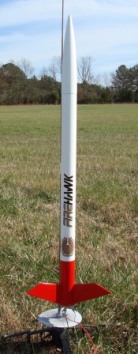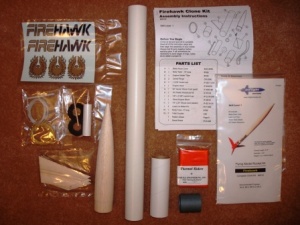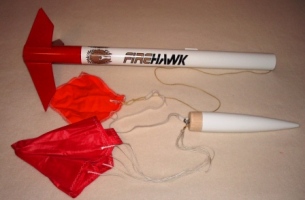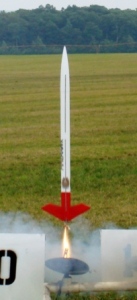
Brief:
While browsing through the manufacturers links on EMRR one fine evening, I happened upon a company called InFlight Rockets. The bulk of their product line included a few original designs and a selection of clone kits. The reviews of their kits on EMRR have been quite favorable, and since most of their clone kits were rockets that I wanted to build, it was only a short time before a box from InFlight showed up on my porch.
Produced by Estes from 1989-1990, and bearing a striking resemblance to the Centuri Firebird, the Firehawk was a large BT-60 based, skill level one rocket that sported forward swept fins, flew on 18mm motors, and recovered with an 18” parachute. I built and flew a lot of Estes kits as a kid in the 1980s, but somehow, the Firehawk and I never crossed paths. The InFlight clone version of the Firehawk is a faithful recreation of this rocket (right down to the recommended B8-5 motor that is no longer available) which also incorporates some modern upgrades that have become more or less standard in the model rocket world.
Construction:
My shipment from InFlight arrived unscathed. Their kits are packaged in the standard plastic bag with a simple header card, and all of the smaller parts individually bagged (nice touch). All of the components in the Firehawk kit were excellent quality.
The following parts are included in the kit:
- Balsa Nose Cone – BNC-60RL
- BT-60 Body Tubes – 18” and 5” sections
- BT-60 Tube Coupler
- 3 Laser Cut Balsa Fins
- 18mm Engine Tube
- 18mm Engine Block
- Standard Engine Hook
- 2 Black Fiber Type BT-20/60 Centering Rings
- 60” of Kevlar Shock Cord
- 24” of 1/4" Elastic Shock Cord
- 3/16” Screw Eye
- 1/8” x 2.5” Launch Lug
- 18” “Thermal Rider” parachute kit from Hartle Engineering (Unassembled)
- Decal Sheet
- Instruction Booklet
- Copy of the NAR Model Rocket Safety Code
The Firehawk is really just a simple 3FNC kit, and putting it together is very straightforward, definitely in the skill level 1 category. The instructions are simple, effective and illustrated well enough that even a first time builder could get this done without any trouble. I used Tite-Bond wood glue for assembly except where noted.
The motor mount is assembled first. The motor mount tube is marked for placement of the aft centering ring, and for cutting a slot for the engine hook. Once the slot is cut, the engine hook is installed and held in place with a wrap of masking tape. The centering rings are installed on the motor mount tube next, and since they are pre-notched, it matters which one goes on which end. The one with the inside notch is placed 1 inch from the aft end, with the notch lined up over the engine hook to allow it to flex. The ring with the notch on the outside goes on the forward end against the engine hook, and will allow the Kevlar® shock cord to pass. The thrust ring is glued into the forward end of the motor tube against the engine hook. The Kevlar® shock cord is attached to the motor mount by tying it around the motor tube behind the forward centering ring, and then laying the cord in the notch to allow it to reach the front of the rocket. I must also add that of all the rocket kits I have ever seen, InFlight kits are the ONLY ones where I have not felt it necessary to add a longer shock cord. The Kevlar® is typically about twice the length of the rocket, and the elastic adds another couple of feet. Bravo InFlight! Finally, I reinforced all of the centering ring to motor tube joints with glue fillets.
While the motor mount glue was drying I got the fins out of their sealed bag. Since they are laser cut and essentially identical, there isn’t really any need to sand them, although the instructions specifically explain and illustrate the process of stacking them together and sanding the edges. I did round the leading and trailing edges, although you could certainly use the fins straight out of the bag.
Next the motor mount is installed in the 5 inch section of body tube. First I threaded the Kevlar® back through the motor tube to keep it out of the way, and did a test fit to make sure everything slid easily into the body tube. Next I swabbed a ring of glue inside the body tube near where the forward centering ring would rest, and slid the motor mount into position with the end of the motor tube even with the end of the body tube. Once the glue set up I also added a fillet to the aft centering ring where it meets the body tube. The two body tube sections are then joined by gluing the tube coupler into the forward end of the short section, and then into the longer section. My standard practice for joining tube sections is to roll the final assembly on a flat surface (like a glass table-top) to make sure everything is straight, then stand the tube on one end until the glue sets.
A wrap-around fin marking template is included in the instructions. Once the positions of the fins and launch lug are marked I used a section of small aluminum angle from a local hardware store to extend the lines as required. The fins for the Firehawk are attached flush with the aft end of the body tube. The launch lug is cut into two pieces with one attached at the aft end of the body tube, and one 15 inches from the aft end. I did not do anything special to line up the launch lugs. I find that if I draw a continuous line the length of the body tube then it is pretty easy to get them lined up with just my calibrated eyeball. The fins and launch lug are attached with a small bead of wood glue, and reinforced with wood glue fillets.
Several final assembly steps are completed after the finishing process. I typically install the screw eye by screwing it part way into the base of the nose cone, removing it, adding a large drop of medium thickness CA glue and then screwing it all the way down. The Kevlar® shock cord is fished out from the motor mount, the elastic cord is tied to the Kevlar® line and then to the nose cone, with a drop of thin CA glue on all the knots.
Finishing:
Finishing the Firehawk is fairly easy as well. I used Elmer’s wood filler to add smooth fillets to the fin and launch lug joints. The nose cone and fins were sealed with two coats of thinned down wood filler and sanded smooth. My standard finishing routine is 2 coats of primer (Rust-Oleum Painter’s Touch Sandable Primer) and then 2 coats of Krylon spray enamel, working down to 400 grit sandpaper between coats. The nose cone and forward 18 inches of the body are painted gloss white, and the aft 5 inches of the body along with the fins are painted gloss red. The decals included with the Firehawk were excellent, great colors and very clean. The instructions do not advise any type of coating before applying. The individual decals are fairly large, and so a little care must be taken when handling and positioning them to avoid any folding or tearing. Overall the decals were easy to work with and set up very nicely. The instructions do recommend clear coating the finished rocket to protect the decals, and I used Testors Gloss-Coat. After everything had dried I noticed that there was some very faint color bleeding near the decals, but I couldn’t tell if it was from the red paint or the decals. I had never observed this result before with this combination of finishes, so I chalked it up to the conditions at the time. The end result is a nice looking rocket with unique lines, simple paint scheme, and eye catching decals.
Construction Rating: 4 out of 5
Flight:
The Firehawk is big, the Firehawk is heavy, the Firehawk is over-stable, the Firehawk is not a high performance model by any means. It is meant to fly low and slow and look cool doing it. Unfortunately, the Firehawk borders on the edge of too heavy, and if you tend to do a lot of filling and finishing with multiple coats of sealer and paint then you will end up with a bit of a problem. The Firehawk is advertised with a finished weight of 3 oz, and the real world version (mine) came in at 4.1 oz. I had built a RockSim file for the Firehawk, and when I ran the simulations I discovered that it was now marginal to fly on a “B” motor, and that it would be extremely slow coming off a standard length launch rod even with a “C” motor. I took it out to a club launch and learned that there were no long 1/8 inch rods to be found. On top of that it was a very windy day (10 kts plus). What to do… well fly it anyway of course. I packed the chute, loaded up a C6-3, called a heads up flight and pushed the button. The Firehawk lumbered off the pad, and immediately tipped over into the wind at about a 45 degree angle. Motor burnout was probably around 200 feet with the rocket travelling horizontal. The three second delay ticked off and the ejection charge fired at about 50 feet. The chute came out clean, the rocket jerked to a stop and floated gently down to the sod without a scratch. Figuring I had used up my luck for the day I put it back in the car. I subsequently flew it again on C6-3s, with much less wind, and even though it still tipped off pretty hard the resulting flights were not as dramatic. Determined to get an impressive flight out of the Firehawk I finally loaded up a composite D10-5 and sent it up on a beautiful flight, although it definitely doesn’t qualify for low or slow on that motor. Eventually I acquired a 48 inch launch rod which is just what this rocket needed to turn in nice straight flights on a C6-3 motor.
Recovery:
 The Firehawk comes with an unassembled 18 inch plastic parachute from Hartle Engineering. The instruction manual includes the steps for assembling the parachute, which is fairly standard. Tape reinforcement disks are applied to the corners of the chute, and there are enough disks for both sides (a nice detail). The shroud line is cut into three equal lengths and then tied through the disks at each corner of the chute. The instructions direct you to pass the shroud lines through the screw eye in the nose cone and then thread the chute back through the loop. You are then directed to pull the shroud lines tight and set the knot around the screw eye with a drop of glue. This is the only step in the instructions that I would actually advise someone NOT to do. First off, attaching the parachute directly to the nose cone will eventually result in tangled shroud lines, and so I always attach my chutes to a fishing type swivel and then to the rocket. My real concern, however, is that by gluing the shroud lines to the nose cone, you are left with no way to untangle the chute when it does get snarled up. This is probably the only item that could be improved in this kit. I also attached a 6x6 inch Nomex® heat shield to the Kevlar® shock cord to eliminate the need for wadding. Since the first flight of my Firehawk happened on a very windy day, I actually used a 15 inch Top Flight nylon chute, and since the rocket recovered without any problems I have stuck with this setup ever since.
The Firehawk comes with an unassembled 18 inch plastic parachute from Hartle Engineering. The instruction manual includes the steps for assembling the parachute, which is fairly standard. Tape reinforcement disks are applied to the corners of the chute, and there are enough disks for both sides (a nice detail). The shroud line is cut into three equal lengths and then tied through the disks at each corner of the chute. The instructions direct you to pass the shroud lines through the screw eye in the nose cone and then thread the chute back through the loop. You are then directed to pull the shroud lines tight and set the knot around the screw eye with a drop of glue. This is the only step in the instructions that I would actually advise someone NOT to do. First off, attaching the parachute directly to the nose cone will eventually result in tangled shroud lines, and so I always attach my chutes to a fishing type swivel and then to the rocket. My real concern, however, is that by gluing the shroud lines to the nose cone, you are left with no way to untangle the chute when it does get snarled up. This is probably the only item that could be improved in this kit. I also attached a 6x6 inch Nomex® heat shield to the Kevlar® shock cord to eliminate the need for wadding. Since the first flight of my Firehawk happened on a very windy day, I actually used a 15 inch Top Flight nylon chute, and since the rocket recovered without any problems I have stuck with this setup ever since.
Flight Rating: 4 out of 5

Summary:
PROS: A nice kit from “back in the day”. Larger sized 3FNC rocket with unique forward swept fins, nice lines, simple construction, and an eye catching decal set.
CONS: Instructions for attaching the parachute to the rocket are not well thought out in my opinion. There just isn’t any good reason to permanently attach your recovery device to your rocket. A snap swivel and a little re-write to the instructions would make this kit perfect.
Overall Rating: 4 out of 5
Other:
I’m not sure why this kit was ever produced with an 18mm motor mount. Even if you build it light, it simply can’t perform well on standard 18mm black powder motors. If you build it heavy to any degree your options for flying this bird become limited. A longer launch rod will help you in the low and slow regime, and 18mm composite motors or a 24mm motor mount will make the Firehawk jump!



 The Firehawk comes with an unassembled 18 inch plastic parachute from Hartle Engineering. The instruction manual includes the steps for assembling the parachute, which is fairly standard. Tape reinforcement disks are applied to the corners of the chute, and there are enough disks for both sides (a nice detail). The shroud line is cut into three equal lengths and then tied through the disks at each corner of the chute. The instructions direct you to pass the shroud lines through the screw eye in the nose cone and then thread the chute back through the loop. You are then directed to pull the shroud lines tight and set the knot around the screw eye with a drop of glue. This is the only step in the instructions that I would actually advise someone NOT to do. First off, attaching the parachute directly to the nose cone will eventually result in tangled shroud lines, and so I always attach my chutes to a fishing type swivel and then to the rocket. My real concern, however, is that by gluing the shroud lines to the nose cone, you are left with no way to untangle the chute when it does get snarled up. This is probably the only item that could be improved in this kit. I also attached a 6x6 inch Nomex® heat shield to the Kevlar® shock cord to eliminate the need for wadding. Since the first flight of my Firehawk happened on a very windy day, I actually used a 15 inch Top Flight nylon chute, and since the rocket recovered without any problems I have stuck with this setup ever since.
The Firehawk comes with an unassembled 18 inch plastic parachute from Hartle Engineering. The instruction manual includes the steps for assembling the parachute, which is fairly standard. Tape reinforcement disks are applied to the corners of the chute, and there are enough disks for both sides (a nice detail). The shroud line is cut into three equal lengths and then tied through the disks at each corner of the chute. The instructions direct you to pass the shroud lines through the screw eye in the nose cone and then thread the chute back through the loop. You are then directed to pull the shroud lines tight and set the knot around the screw eye with a drop of glue. This is the only step in the instructions that I would actually advise someone NOT to do. First off, attaching the parachute directly to the nose cone will eventually result in tangled shroud lines, and so I always attach my chutes to a fishing type swivel and then to the rocket. My real concern, however, is that by gluing the shroud lines to the nose cone, you are left with no way to untangle the chute when it does get snarled up. This is probably the only item that could be improved in this kit. I also attached a 6x6 inch Nomex® heat shield to the Kevlar® shock cord to eliminate the need for wadding. Since the first flight of my Firehawk happened on a very windy day, I actually used a 15 inch Top Flight nylon chute, and since the rocket recovered without any problems I have stuck with this setup ever since.















G.B. (February 1, 2010)